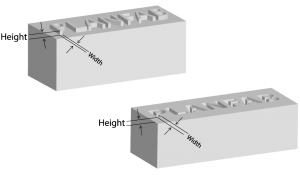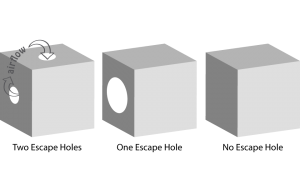Recommendations to keep in mind when designing in order to have successful products in Castable.
![]()
![]()
![]()
Material Info
Castable Resin burns out cleanly without ash or residue and captures crisp, precise detail and smooth surfaces. Jewelers and designers can go straight from a 3D design to a model for direct investment. Models made out with this 3d print technology are constructed from photo-reactive resin. This material can be used to create jewelry and models for investment casting.
The look and feel of the models can be described as smooth. The material is brittle, but stronger compared to wax, smooth and of course with fine detail. Castable resin is suited for models going for investment casting. Therefore, it’s ideal for jewelry making.
The process uses visible spectrum light to cure the liquid resin one layer at a time. A resin bath sits above a laser which hits the surface of the resin at specific spots according to the geometry of the model. The resin immediately cures and turns into plastic, thus, creating one layer of your model each time. This process is called Stereolithography (SLA). Once the model is printed, we take it off the machine platform and post process it with IPA and UV cure it.
Disclaimer:
Bounding Box (size)
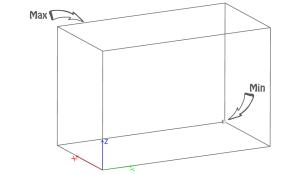
The bounding box represents the size we are able to print at once.
Min X + Y + Z ≥ 10mm
In order to be able to print your model, each of its pieces must be greater to those dimensions.
If the bounding box of your model is not bigger than our minimum, try scaling it up or making it thicker or enlarging some of its parts/features or any combination of the above.
Max 100x100x100mm
In order to be able to print your model, each of its pieces must fit within those dimensions.
If the bounding box of your model is bigger than our maximum, try scaling it down or removing unnecessary features/parts or cutting it to smaller parts or any combination of the above.
Wall thickness (minimum)
It represents the minimum wall thickness required in order to be able to produce your model, ship it and reach you unharmed. A wall could also be defined as the distance between two parts which form a closed and solid mesh.
Tip: The thicker the model, the more solid and safer to handle it gets. We recommend thicker walls for big and/or complex designs. The geometry of the model plays a crucial role on the solidity as well.
Supported (min 0.4mm at print size)
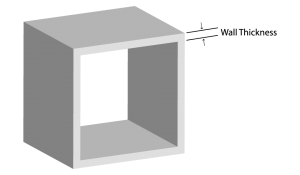
A wall is considered supported if it is connected to two or more walls on at least two of each sides.
If any supported walls are not thicker than the minimum required, try making them thicker, or adding supports or both.
Unsupported (min 0.6mm at print size)
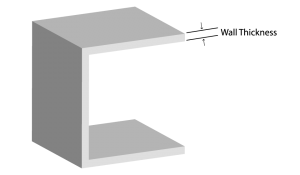
A wall is considered unsupported if it is connected to other walls on one side only.
If any unsupported walls are not thicker than the minimum required, try making them thicker or adding supports or both.
Wires
Wires are long and thin features of a model. As wire is considered a part whose length is two times greater than its width.
Tip: In general, wires follow the same rules as walls; nevertheless, due to their delicate nature you should be extra cautious when designing them.
Supported (min 0.6mm at print size)
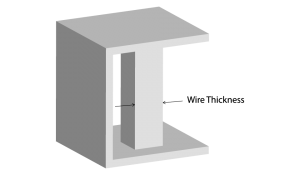
A wire is considered supported if it is connected to two or more walls on at least two of each sides.
If any supported wires are not thicker than the minimum required, try making them thicker, or adding supports or both.
Unsupported (min 1.0mm at print size)
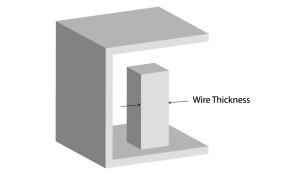
A wire is considered unsupported if it is connected to other walls on one side only.
If any unsupported wires are not thicker than the minimum required, try making them thicker, or adding supports or both.
Details
As details are considered all those features whose length is less than two times their width. Details could be either embossed or engraved on a surface.
Make sure your detail’s length and width is greater than the minimum required, or else they won’t be clear and visible (the larger the detail, the more visible and clear it gets).
If any details on your model are not greater than the minimum required try making them bigger or removing them.
Engraved
Minimum line thickness ≥ 0.1mm
Minimum depth ≥ 0.1mm
Embossed
Minimum line thickness ≥ 0.1mm
Minimum depth ≥ 0.1mm
Escape holes
Drain holes are recommended for resin to escape in models that are a fully enclosed cavity (like a hollow sphere or hollow cylinder printed directly on the build platform). Without drain holes of at least 3.5 mm in diameter, the part may trap resin and lead to an explosion of the print.
If the model has complex geometry with many separate hollow cavities, make sure there is an escape route for every cavity.
If your escape holes are not sufficient and over the minimum requirements, try enlarging them or adding more or filling the hollow space or any combination of the above.
Clearance (0.1mm at print size)
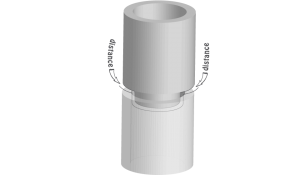
Clearance is the distance between any two parts.
If your clearance is not over the minimum required, try making it greater or fuse the parts together if their independence is unnecessary.
Interlocking and enclosed parts
While we can print interlocking and enclosed parts, these are extremely difficult to cast and we do not recommend it.
Multiple parts per model file
Yes. Multiple parts per model file can be processed and produce in Full Color Sandstone.
Material Traits
Castable Resin allows you to print in Fine Detail, with a material created specifically for direct investment casting. This resin burns out cleanly with no ash or residue, making it perfect for jewelry.
Burnout Schedule
We’ve tested the burn-out schedule below with great results using R&R Plasticast with BANDUST. This investment was developed specifically to work with photopolymers like Castable Resin.
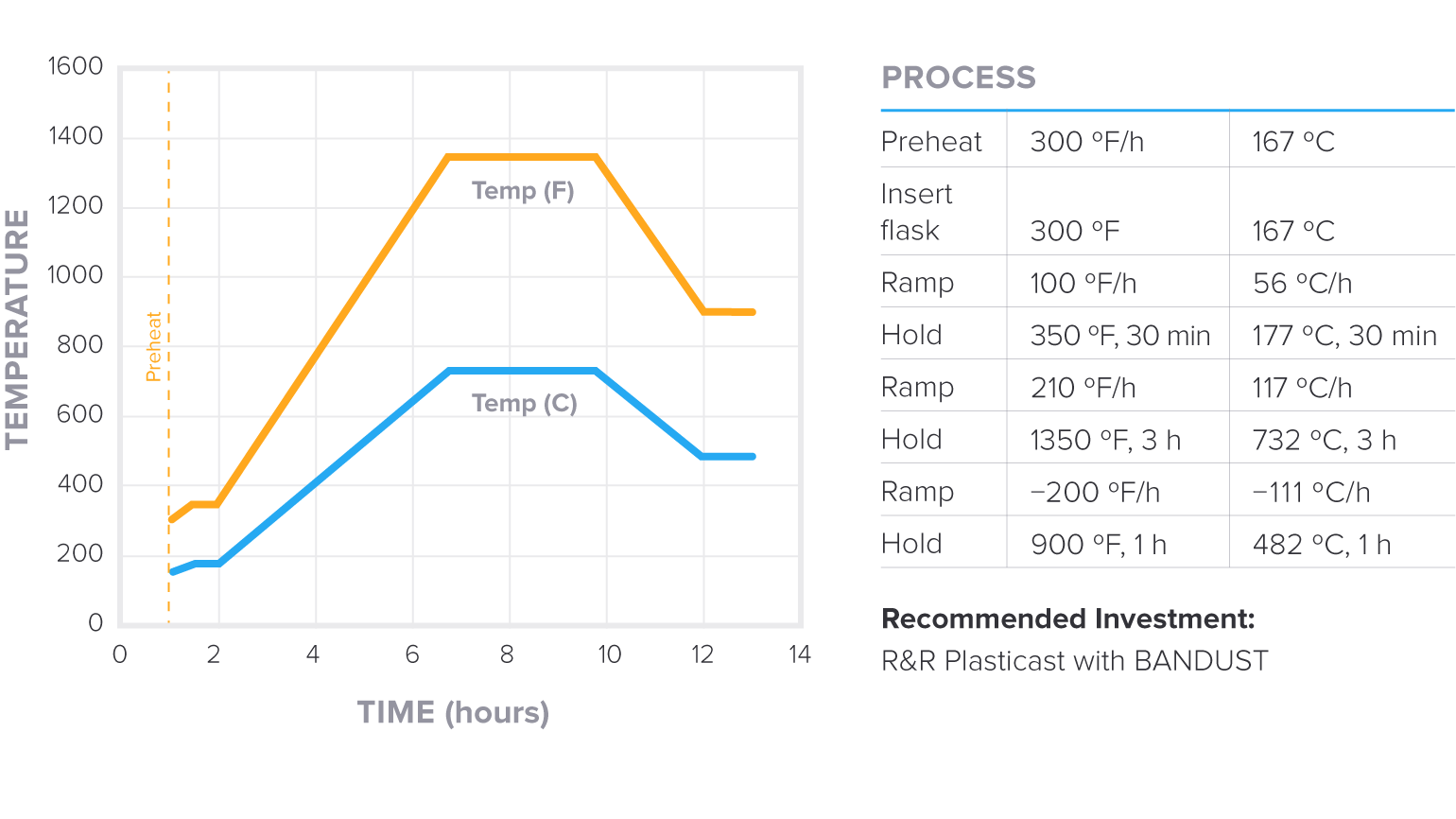
Tip
If you are experiencing difficulty with this burnout curve, you can try:
Extending the 30 minute suggested Hold time at 350 °F / 177 °C.
Post-curing parts for longer. We suggest a minimum of four to six hours, but thicker pieces especially will need more time. This step is critical in preparing prints for burnout.
If you cannot use R&R Plasticast with BANDUST, look for an investment recommended for use with photopolymers. You can also experiment with bonded investments, like those typically used for Dental applications.
Not following the burnout schedule may result in damaged parts.
Assembly
Be careful when designing parts intended to be assembled, it is possible that the size of a model is not exactly the same size with your design. Thus, if your parts are not designed with some tolerance/distance, they might not fit together. Try to have at least 0.5mm distance between the parts at the assembly point. We generally recommend, in cases you need a tight fit such as a screw in a hole, print the object and drill it afterwards.

